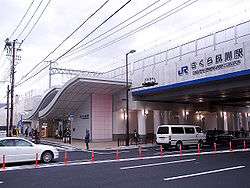Sakura Shukugawa Station
Sakura Shukugawa Station (さくら夙川駅, Sakura Shukugawa eki) is a train station located in Kagura-chō (神楽町), Nishinomiya, Hyōgo Prefecture, and is operated by the West Japan Railway Company. The station is on the JR Kobe Line which runs between Osaka Station and Himeji Station; part of the Tōkaidō Main Line. The station was built between two existing JR stations, Nishinomiya Station and Ashiya Station. As a part of the JR West Urban Network, the following cards are accepted: J-Thru Card, ICOCA, Suica, and PiTaPa.

The station's name comes from the park approximately 200m west of the station, Shukugawa Park (夙川公園). The park is situated on the banks of the Shukugawa riverbed and is famous for its annual display of Cherry Blossoms, and is quite a popular site for flower viewing parties.
Station Layout and Design
Station Placement
Most of the JR Kobe Line runs on four tracks (複々線, Fukufukusen), meaning that there are two tracks for each direction. Similar to other stations such as Kōnan-Yamate Station, Sakura Shukugawa Station is of the island type, that is situated between the four tracks. Specifically, it is between the two inner tracks that provide local service. Local trains stop at this station. Rapid Service trains pass the station on the same track, but do not stop. Special Rapid Service and other Limited Express trains pass by on the outer track.
Building Design
With regard to the design of the station building, the basic concept was to give the station a natural warmth and vibrance. The roof line is a conceptual representation of waves flowing down the Shukugawa River, and the walls are the color of cherry blossoms.
Hyōgo Prefecture Highway 82 passes underneath the platform and tracks.
Gates
The station has only one gate, located on the south side of the station.
Train Platforms
| 1 | ■ JR Kobe Line (Tōkaidō Main Line) | for Sannomiya and Himeji |
|---|---|---|
| 2 | ■ JR Kobe Line (Tōkaidō Main Line) | for Amagasaki, Ōsaka and Kitashinchi |
Area Around the Station
- Shukugawa River (West of the station)
- Shukugawa Park (West of the station)
- Hankyū Kōbe Line - Shukugawa Station (To the northwest)
- Hanshin Main Line - Nishinomiya Station (To the southeast) and Kōroen Station (To the southwest)
- Route 2
- Nishinomiya Jinja (Eight minutes walk south)
Station history
- 2001 - Construction began. Tentative station name: JR Shukugawa (JR夙川駅).
- 22 November 2006 - Official station name announced: Sakura Shukugawa (さくら夙川駅).
- 18 March 2007 - Station opens to the public and passenger service begins.
Adjacent stations
| « | Service | » | ||
|---|---|---|---|---|
| JR West Tōkaidō Line (JR Kobe Line) | ||||
| Nishinomiya (JR-A52) | Local | Ashiya (JR-A54) | ||
| Rapid Service: Does not stop at this station | ||||
| Special Rapid Service: Does not stop at this station | ||||
History
Generally, the local government encourages people to petition for a new station to be built, however, the widening of Prefecture Road 82 was already underway and funded by the federal government. Therefore, Nishinomiya didn't have the burden of petitioning for the station, but rather JR West went to the government and began design the plans. Prefecture Road 82, directly below the station, had already been undergoing construction to widen the road, so when the construction of the station began, both construction sites were operating at the same time, one on top of the other.
In preparation of JR Sakura Shukugawa Station's opening, on 28 October 2006, both Hankyū Railway and Hanshin Electric Railway altered their schedules and changed which trains would stop at the stations that are direct competitors of JR Sakura Shukugawa Station. At Hankyū Shukugawa Station, where before only local service stopped, now Limited Express and Commuter Express would stop. At Hanshin Kōroen Station, Limited Express trains began stopping in the morning. These changes were made, it is thought, to go head-to-head with the new JR Sakura Shukugawa Station.
Before the station opened to the public, there was no practice for stopping the train at the station in an actual train. Training was presented in a classroom. The train operator labor union severely opposed this. In response, it was decided that for any operator stopping at Sakura Shukugawa Station for the first time would be accompanied by an instructor.
Related Items
External links
- JR West - Sakura Shukugawa Station (Japanese Only)
- Ekikara.jp - Sakura Shukugawa Station Time Table (Japanese Only)
- Shukugawa Marugoto Web Guide - Shukugawa Area Guide (Japanese Only)